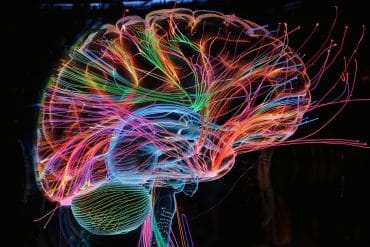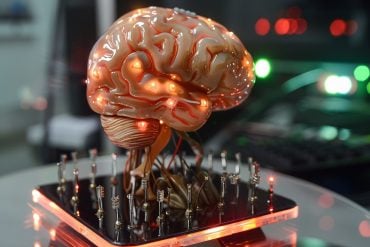Most of us think of infants as tiny beings whose main business is to sleep, suck and cry, without much awareness of what is happening around them. It may come as somewhat of a surprise to know that newborn brains are full of feverish activity and that they are already gathering and processing important information from the world around them.
At just two days after birth, babies are already able to process language using processes similar to those of adults. SISSA researchers have demonstrated that they are sensitive to the most important parts of words, the edges, a cognitive mechanism which has been repeatedly observed in older children and adults.
It is well-known that, in general, people better remember the edges of sequences and particularly in language, when we must remember and recognize words, the brain gives greater weight to information at the beginning and the end of the word. Languages around the world seem to capitalize on this encoding at the edges. “The syllables at the beginnings and the ends of words often carry important information. For example, the parts of words that contain information about plurality of objects or verb tense are almost always found at the beginning or at the end of words in all known languages,” says Alissa Ferry, researcher at the International School for Advanced Studies of Trieste (SISSA) and author of the study.
“It is a pervasive phenomenon and our study shows that it is present from birth,” says Ana Flo, a SISSA researcher who was involved in the study. “Here at SISSA, researchers already showed that pre-linguistic babies of 7-8 months show this enhanced encoding of word edges, but we went further, showing that this mechanism is present in humans even during the first days of life.”
“The infants heard a sequence of six syllables and we examined to see if they could discriminate it from a very similar sequence, in which we switched the positions of two of the syllables. When we switched the edge syllables, the newborns’ brain responded to the change, but when we switched the two syllables in the middle, they did not respond to the change. This suggests that the newborns better encoded the syllables at the edges of the sequence,” says Perrine Brusini, a SISSA researcher and one of the study’s authors.
In real language there are signals, like prosody or very subtle pauses, that cue the boundaries between words and phrases. This may help us remember words from even longer discourse. “In another series of experiments, we tried to find out if neonates can use these cues to process the syllables in the middle of the sequence,” continues Flo. “To do that we introduced a small discontinuity between the two middle syllables, an almost imperceptible 25 millisecond pause, and examined whether infants would now notice the switch between the middle syllables. With this very subtle cue, the neonate brain treated the sequence as two shorter words and responded when the syllables switched.”

Humans better encode information from the edges of sequences and this cognitive mechanism can influence language acquisition even from the first days of life, conclude SISSA researchers.
Behind the scenes research fact
How do you figure out what is happening in the brain of a newborn (without disturbing the baby too much)? While not an easy process, there are experimental methods that take advantage of the “habituation” phenomenon and can be used to figure out how children think and learn.
When hearing a stimulus repeatedly, the brain response habituates: it responds stongly for a new stimulus but after hearing the same things repeatedly, the response to that stimulus decreases. If you change the stimulus, the brain response becomes strong again. Using non-invasive infrared spectroscopy, brain activity can be measured: “We had the newborns listen to the same word repeatedly and then we played the word with the syllables switched. If the newborn brain detected the difference, we see an increased brain response. The brain response increased when we switched the syllables at the edge of a word but not when we switched the syllables in the middle of a word, indicating that edges were encoded better,” explains Ferry.
Source: SISSA
Image Credit: The image is credited to NeuroscienceNews.com
Original Research: Abstract for “On the edge of language acquisition: inherent constraints on encoding multisyllabic sequences in the neonate brain” by Alissa L. Ferry, Ana Fló, Perrine Brusini, Luigi Cattarossi, Francesco Macagno, Marina Nespor and Jacques Mehler in Developmental Science. Published online July 17 2015 doi:10.1111/desc.12323
Abstract
On the edge of language acquisition: inherent constraints on encoding multisyllabic sequences in the neonate brain
To understand language, humans must encode information from rapid, sequential streams of syllables – tracking their order and organizing them into words, phrases, and sentences. We used Near-Infrared Spectroscopy (NIRS) to determine whether human neonates are born with the capacity to track the positions of syllables in multisyllabic sequences. After familiarization with a six-syllable sequence, the neonate brain responded to the change (as shown by an increase in oxy-hemoglobin) when the two edge syllables switched positions but not when two middle syllables switched positions (Experiment 1), indicating that they encoded the syllables at the edges of sequences better than those in the middle. Moreover, when a 25 ms pause was inserted between the middle syllables as a segmentation cue, neonates’ brains were sensitive to the change (Experiment 2), indicating that subtle cues in speech can signal a boundary, with enhanced encoding of the syllables located at the edges of that boundary. These findings suggest that neonates’ brains can encode information from multisyllabic sequences and that this encoding is constrained. Moreover, subtle segmentation cues in a sequence of syllables provide a mechanism with which to accurately encode positional information from longer sequences. Tracking the order of syllables is necessary to understand language and our results suggest that the foundations for this encoding are present at birth.
“On the edge of language acquisition: inherent constraints on encoding multisyllabic sequences in the neonate brain” by Alissa L. Ferry, Ana Fló, Perrine Brusini, Luigi Cattarossi, Francesco Macagno, Marina Nespor and Jacques Mehler in Developmental Science. Published online July 17 2015 doi:10.1111/desc.12323






